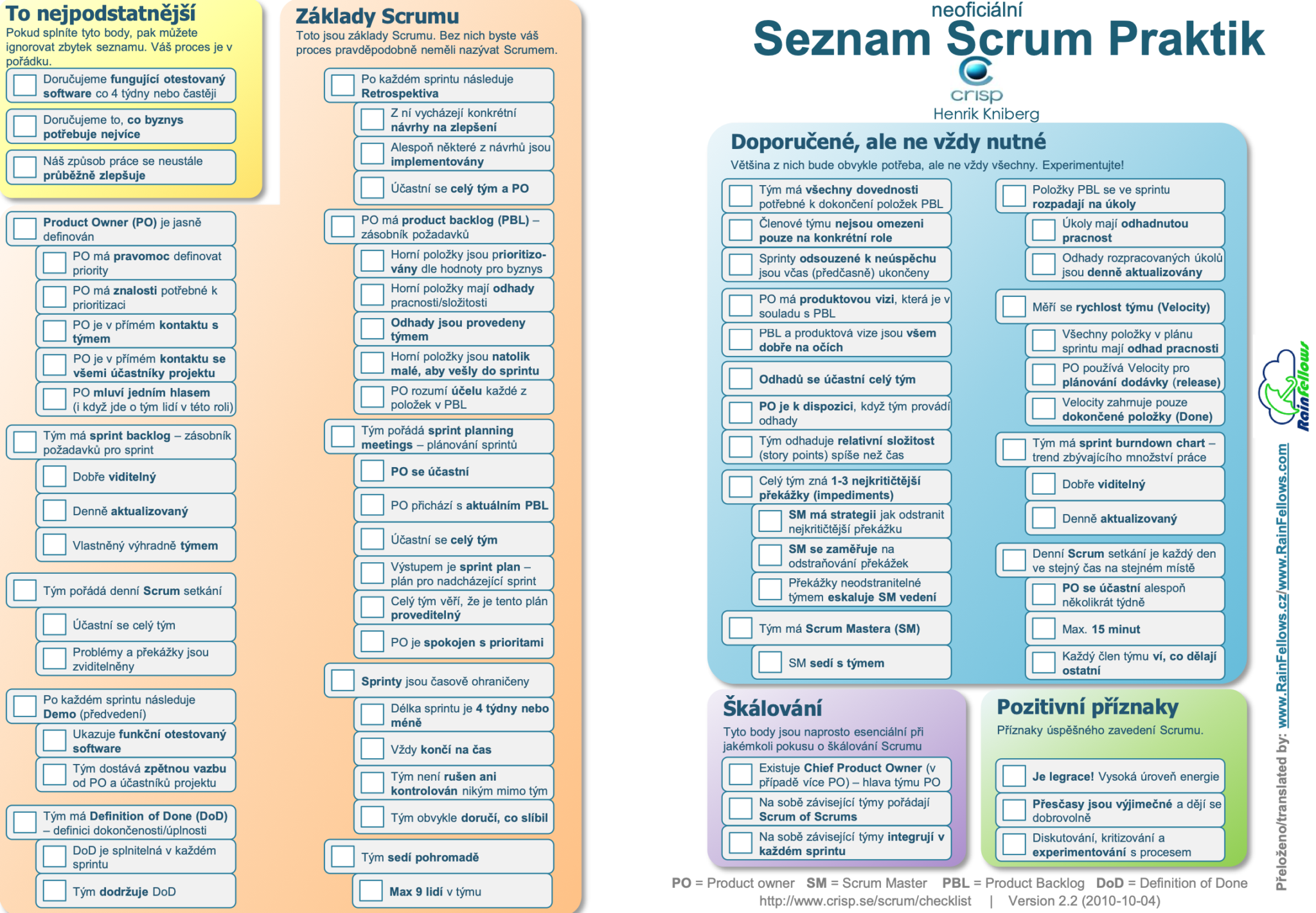Henrik Kniberg put his time together list of Scrum practices. From time to time we use it successfully when implementing Scrum in teams, so we decided to translate it into Czech and share it with you. The list for you can be a good inspiration for further team development or it can serve as a quick barometer of Scrum rollout.
English translation you can download hereunder.
How to use the Scrum checklist?
Tip #1:
Try using this list as part of regular retrospectives on teams implementing Scrum. Choose from a few practices that you want to implement in the team (10-12 max.) and let the team vote during the retrospective to what extent they think the practice already works in the team (we recommend using the card voting technique as in Planning Poker, so that team members do not influence each other).
If the average value for a given practice is low, then let the team discuss what actions can help implement it.
If the team does not match in the vote (large variance of answers), then let the team members discuss why they voted differently.
If you want to help with the implementation of regular self-assessment of the team, then do not hesitate to contact us contact.
Tip #2:
Transfer this list to Google Forms for easier input collection by filling in team members before the retrospective.
Translation of the original text by Henrik Kniberg
The following lines are a translation of the original text by Henrik Kniberg given at this address.
Who is this list for and what is it for?
The Scrum Practices List is a simple tool to help you get started with Scrum or evaluate your Scrum implementation.
Please note that these are not rules, only recommendations. For example, a team of two can choose to skip the daily Scrum meeting because they program in pairs all day anyway and do not need another synchronization meeting. It's prime. They deliberately chose to omit one of the Scrum practices, however, they ensured that the purpose of the practice was assured in a different way. And that's what matters!
If you work according to Scrum, it may be interesting for you to use this list during a team retrospective. As a tool for discussion, not evaluation.
How do I use it?
Jarda: “I brought a short interesting list of Scrum practices to today's retrospective. Is there anything about him that we're not doing?”
Kate: “So let's look at it. Hm, we definitely miss Definition of Done, and we don't watch Velocity either.”
Jarda: “OK, 'Definition of Done' is listed in the “Scrum Basics” section, so it looks important! Velocity is in the 'Recommended but not always necessary' section so let's wait with that and start with the most important.
Kate:” Hey, we also miss 'Deliver working tested software every 4 weeks or more often'. This is even mentioned in the 'Most essential' section!
And it makes sense because marketing complains about it all the time!”
Jarda: “Perhaps the concept of 'Definition of Done' could help us take smaller units into the sprint and deliver more often? “
Kate: “Good idea, let's try it.”
How not to use it!
Big boss: “Okay, team, it's time to see how you follow Scrum. Please complete this questionnaire.”
Jarda: “Boss, I'm glad to say we're doing everything off the list. Well, perhaps only except for the Sprint burndown charts.”
Big boss: “You are the wrong team! It clearly says here you're supposed to do... those... sprint burning things! I want to see them!”
Katka: 'But we have two-week sprints and we almost always deliver what we promise and customers are satisfied. Sprint burndown charts wouldn't help us in any way right now.”
Big boss: “But it clearly says you're supposed to have them, so either it doesn't happen again or I'll call the Scrum police!”
Is this list official?
He's not. This list reflects my personal subjective opinion of what is essential in Scrum. I've been helping companies get started with Scrum for years, and I've met hundreds of Scrum users, coaches, and coaches; and I've found that a list like this can be useful when used properly.

